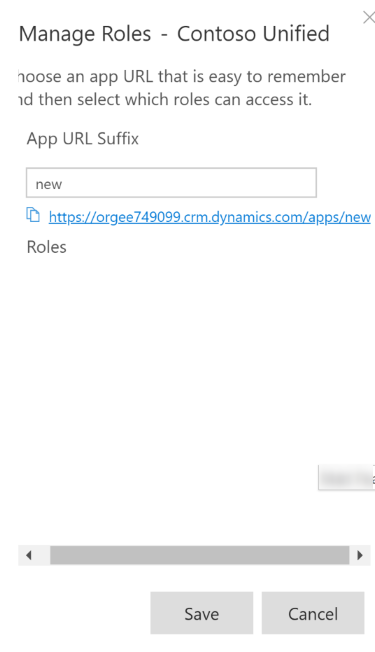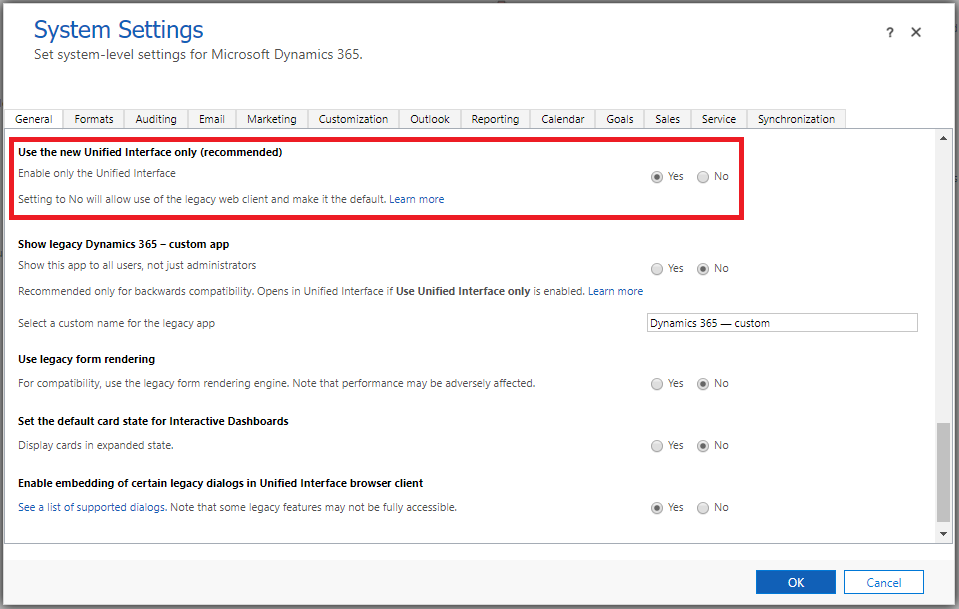Using an existing environment to validate your legacy web client app with the Unified Interface
This blog shows you how to use an existing environment to create a Unified Interface app based upon your current configuration or default solution. This allows you to explore and test the Unified Interface while running your existing legacy web client applications in parallel. A user can then switch between environments for a side-by-side view.
Process for validating your legacy web client app in an existing environment
The process for validating your legacy web client app in an existing environment includes three steps, which are detailed below:
- Create a new solution that’s based on the default solution
- Create a new model-driven app
- Configure app properties
If you have recently switched the Use Unified Interface only mode to On in your development environment, you must turn the setting back to Off so you can run the existing legacy web client apps.
1. Create a new solution that’s based on the default solution
- Sign in to the PowerApps maker portal.
- From the list of environments, select the environment you want.
- On the left navigation pane, select Solutions.
- On the menu bar, select New solution.
- On the New solutionpane, enter the following properties:
- Name. Enter a name for the solution. For example, Unified Interface App.
- Publisher. Select the publisher that your organization uses. Be sure to follow your customization governance for your existing customizations. This will ensure the schema names for the model-driven app and its site map are consistent with your existing standards.
- Version. This should be set following your existing standards and governance for solutions.
- Select Create.
- The new solution is created in the list of solutions. Select it to open the solution and go to the next section.
2. Create a new model-driven app in the new solution
In this step you will create a new app that leverages your existing customization’s so that you can experience them in the Unified Interface. You create the app within the container of the new solution, which you created in the previous section.
- On the menu bar select New, point to App, and then select Model-driven app.
- On the Create a New App page, enter the following properties:
- Name. Enter a name for the application as you see fit. For example, Your Application Name+ New or Unified Interface Test.
- Unique Name. This begins with your solution prefix and the simplified version of the app name you specified. You can make changes or leave it as it appears.
- Description. Add a description for the app, such as For testing purposes of the new Unified Interface of our solution.
- Select Use existing solution to create the App, and then select Next.
- In the Select Solution list select Default Solution, in the Select Sitemap list select Site Map, and then select Done.

- The App Designer opens, displaying all the app components that were in the default solution. Select Publish.
- After the publishing process completes, select Play.
A new window opens in the browser with your new model-driven app that contains all of the entities, sitemap, and sitemap customization’s that were in your default Dynamics 365 for Customer Engagement application.
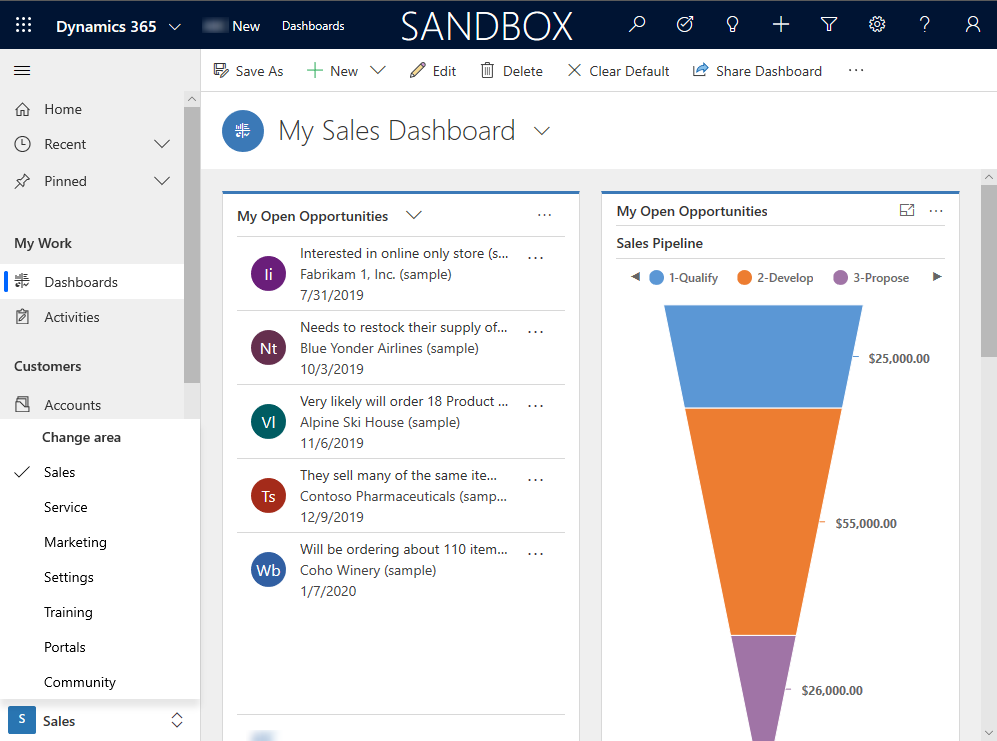
Notice that when you go back to the browser tab with the PowerApps maker portal Solutions area, your new model-driven app and a similarly named sitemap client extension are both part of the solution you created.

In this step, you created a new model-driven app inside of a solution, which you can import into your testing or evaluation environments. You could start to experience the new app now, but before doing so, in the next step, you’ll configure a couple of settings for the new app. Doing this will make it possible to share with other users.
3. Configure app properties
The tasks required to configure the model-driven app properties include:
- Assigning user roles to the new app to enable non-administrators access to use the app.
- Customizing a friendly URL so that a shortcut to the new app can be easily shared, bookmarked, or remembered by users.
- Navigate to environment URL/apps. The URL will look similar to this: https://YourEnvironment.crm.dynamics.com/apps. Doing so opens a list of all the apps in your environment.
- Locate the new model-driven app you created.
- On the app tile, select the ellipsis, and then select Manage Roles.

- The available roles area is listed on the right pane. Select the roles as needed to give non-administrator users access to the app.
- Optionally, in the Manage Roles pane, you can expand the App URL Suffix to customize the friendly URL for the model-driven app. Notice that you can specify most anything. For example, enter new so that the preview displays the URL https://YourEnvironment.crm.dynamics.com/apps/new. This becomes the friendly URL to use and share so that users can directly launch into the experience of the Unified Interface. Users can bookmark this link for their convenience.

- Select Save.
Important
Make sure that all users are granted at least one security role that contains Read access to the Model-driven App privilege. This privilege can be found on the Customization tab within the security role. Users without this privilege receive an error upon opening any model-driven app. Notice that System Administrator and System Customizer security roles already have this privilege enabled.
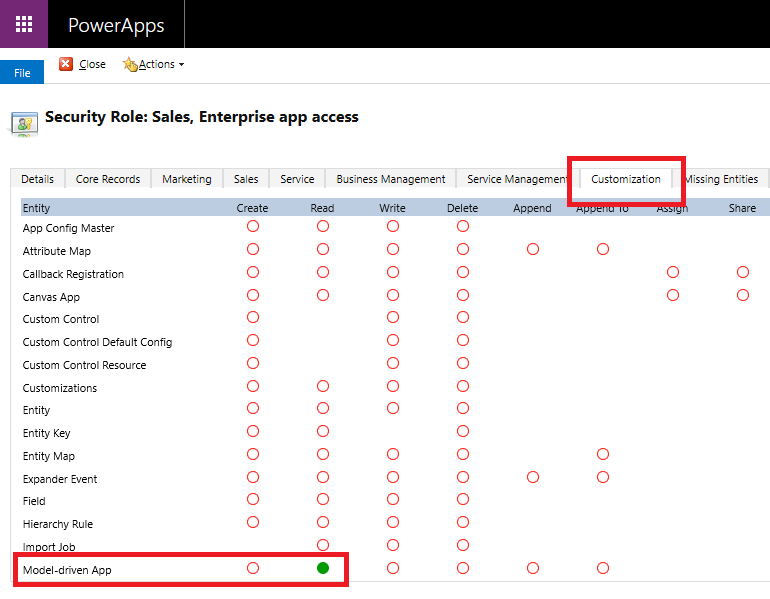
Now, users with the appropriate role can see your new app in the app list on both the Dynamics 365 for Customer Engagement drop-down app list or on the Dynamics 365 Home page (http://home.dynamics.com).
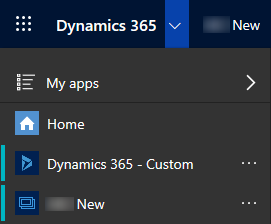
Because the Use Unified Interface only mode is set to Off, when users navigate to the root URL of your environment, they will still land on the default Dynamics 365 – Custom application as before. This is expected if you want to continue supporting your existing legacy web client apps while testing and working on the Unified Interface apps.
Compare your new app to the default Dynamics 365 app
Now you are ready to launch the app. You can compare the new Unified Interface app to the Dynamics 365 – Custom app using the same data, user roles, business rules, workflows, plug-ins, and so on, because they are in the same environment. This allows you to educate your organization that all the core fundamentals are still there, and, at the same time, start to explore the new Unified Interface enhancements.
If you continue to make customization in your default site map, such as changes in the navigation or deeper ribbon customization’s for buttons and actions, you will need to repeat the process by creating another model-driven app or perform the same customization’s in the new site map related to your model-driven app.
Validate your new app
With your application showcasing the Unified Interface, you can start validating your app, processes, and customization’s to identify how the transition will look. We recommend that you test all use cases, but you can start with the most critical ones or group into logical patterns of design. Since the Unified Interface is based on responsive design, we recommend that you always perform tests with different devices that have different screen resolutions. As you test the application you will be able to verify that your customizations are compatible with the Unified Interface and whether there are any features that require a redesign or have missing functionality.
Important
The current version of Common Data Service and Dynamics 365 for Customer Engagement apps still includes several deprecated features. You should review your application for any deprecated features and replace as necessary with new capabilities. More information: Important changes (deprecations) coming in Dynamics 365 Customer Engagement
The PowerApps Checker tool assists in quality checking of your solution’s components. More information: Use solution checker to validate your model-driven apps in PowerApps
Next steps
Based on your findings, your implementation team or partner can estimate the amount of effort needed to transition your application into the Unified Interface and also identify potential usability improvements. With multiple new features and capabilities available in Unified Interface there is an opportunity to increase value for your application users.
Transitioning to the Unified Interface is a great opportunity for you to make a modern user interface and revisit your existing processes to verify that they’re still valid or need improvement. This is also a good time to consider whether your application reflects your business requirements and whether the existing application could be spread across multiple apps for various teams and roles. More information: Design model-driven apps by using the app desi
Updating Existing Environments to Unified Interface
Environments created before June 2019 will not receive the Unified Interface automatically. Version 9.1.0.3448 onwards, administrators will have the option to change the environment settings to get the Unified Interface Only experience. It is recommended by Microsoft to switch to Unified Interface mode by following the steps below:
How to enable Unified Interface Only mode
Unified Interface Only can be turned on and off in one of two ways:
- In Dynamics 365 for Customer Engagement, go to Settings> Administration > System Settings > General Under Use the new Unified Interface only (recommended), select Yes for Enable only the Unified Interface.

- In the Power Platform Admin center, go to Environments and select an environment. Go to Settings > Behavior > Interface settings and then turn on Use Unified Interface only.
Update your apps to Unified Interface
When you enable Unified Interface Only, all your apps, including those designed for the legacy web client, run in Unified Interface all the time. Environments with legacy web client apps will show a notification on the Apps home page, prompting System Administrators to update those apps to Unified Interface, as shown below:
“You are using apps designed for the legacy web client. For best results, update your apps to Unified Interface.”

A similar notification will be visible to System Administrators whenever they use an app designed for the legacy web client, as shown below:
“This app is designed for the legacy web client and might have features or customizations that aren’t supported in Unified Interface. For best results, update it to Unified Interface.”

Additional Resources
Microsoft Playbook – https://docs.microsoft.com/en-us/powerapps/maker/model-driven-apps/unified-interface-playbook
Microsoft Whitepaper – https://docs.microsoft.com/en-us/powerapps/maker/model-driven-apps/approaching-unified-interface
Video – https://www.youtube.com/watch?v=_VPOi_Iq6ko&feature=youtu.be

 RSMUS.com
RSMUS.com

